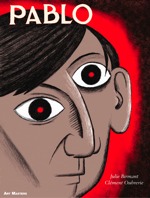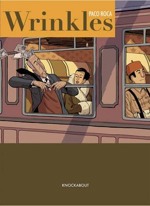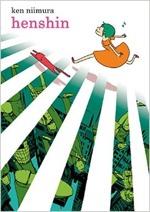My Top Ten Comics Of 2015:
Graphic Novels, Manga & More
“Comics keep getting stuck in the same ten minutes.” I remember Art Spiegelman, ever the apt aphorist, expressing this to me in a conversation at the Barcelona Comic Salon back in the early Nineties and it’s stuck inside my head ever since. The more comics you see, old and new, the more you can spot formula and repetition, shallow thinking, unliving artwork, a lack of questioning or inventiveness. No doubt about it, this way I can easily be completely wrong and blind and misjudge a work, but I do put a fair amount of trust into my very first impressions, my initial burst of concentration and navigation of an unfamiliar comic.
As a result of this process, I seem to have arrived at some sort of private credo or manifesto (temporary at best, I expect) for what I look for in a comic: ’No nostalgia. No loyalty. No limits’. You can’t seduce me and re-sell to me as new what I’ve enjoyed when I was twelve, or twenty, or whenever. You can’t rely on me to follow any character, creator, company or genre unquestioningly, no matter what. You can’t fob me off with bogus novelty, because I am impatient to see the medium we love go beyond those first ten minutes, because an eternity of wonders await us. My personal choices for 2015 hopefully achieve just that and push comics forward.
Drawing from this year’s overflowing cup of strong, striking, often demanding comics, manga and graphic novels, and books about them, here are my personal Top Tens organised into seven categories:
My Top Ten British Graphic Novels of 2015:

1. There’s No Time Like The Present by Paul Rainey (Escape Books)
I cannot be the first publisher-critic ever to put one of their own books at the top as their Best of the Year. I can say with all honesty, that even if I were not this graphic novel’s co-publisher, I would still have picked There’s No Time Like The Present as my favourite British graphic novel of 2015. Thirteen issues and seven years in the making, Rainey’s growing skills at cartooning, characterisation, plot and truly lived dialogue, and his sheer determination to get his ideas and vision down on paper and into print, pulse through this substantial, far-from-slight work. The first graphic novel set in Milton Keynes, it’s a very humorous and humane slice of suburban science-fiction romantic ‘dramedy’ that repays close and repeated readings. In short, There’s No Comic Like There’s No Time Like The Present. That’s why I liked it so much as Paul was self-serialising it, and why Peter Stanbury and I co-published the whole magnum opus, edited, revised and toned with greys, from Escape Books. It also contains by far the most outrageous and hilarious line about Green Kryptonite you will ever read.
2. Becoming Unbecoming by Una (Myriad Editions)
In her debut, Una combines her powerful symbolism and her poignant self-disclosure with an astute re-examination of the frenzy and fallout of the Yorkshire Ripper killings. Raw, revelatory and reaffirming.
3. The Inflatable Woman by Rachael Ball (Bloomsbury)
4. Dispossession by Simon Grennan (Jonathan Cape)
5. Death Of The Artist by Karrie Fransman (Jonathan Cape)
6. Klaxon by Si Spencer & Dix (SelfMadeHero)
7. Take It As A Compliment by Maria Stoian (Jessica Kingsley Publishers / Singing Dragon)
8. Behind The Curtain by Andrzej Klimowski & Danusia Schejbal (SelfMadeHero)
9. Munnu: A Boy From Kashmir by Malik Sajad (Fourth Estate)
10. Everything Is Teeth by Evie Wyld & Joe Sumner (Jonathan Cape)









My Top Ten North American Graphic Novels of 2015:

1. Ruins by Peter Kuper (SelfMadeHero)
A master of political cartooning and ‘silent’ comics, Peter Kuper semi-fictionalises his family’s two-year stay in Oaxaca, Mexico into the sabbatical of a young New Yorker couple. Samantha is a teacher, struggling to write her book, wanting to have a child and reappraising her previous life-changing Mexican experiences there. George is a former artist and unemployed insect specialist, stepping gingerly outside his comfort zone and not feeling ready for fatherhood. After the greys of their Manhattan routine, vivid colour literally floods in, as the pair walk out into arrivals at the airport. Menace, however, is also never far away, personified by the scorpion who doesn’t always stay underneath their bed, and by the city’s corrupt governor who cracks down violently on a teacher’s strike for their annual payrise. Kuper keeps Samantha and George’s relationship and our expectations off-balance. Chapters are divided by four-page visual sequences of one monarch butterfly’s extraordinary flight from taking off out of its chrysalis on US Highway 87 to its reunion with thousands of others in a specific Oyamel pine forest in Mexico, to which our couple make a final pilgrimage to witness the mating spectacle. Kuper makes these interludes resonate with his main narrative, as do passages from Samantha’s writings about Mexican history and beliefs. Through semi-autobiography, travelogue and allegory, Ruins lets us reflect on our related human drives of creation and procreation and what any of us leave behind.
2. Killing And Dying by Adrian Tomine (Drawn & Quarterly)
3. Invisible Ink: My Mother’s Love Affair With A Famous Cartoonist by Bill Griffith (Fantagraphics)
4. The Sculptor by Scott McCloud (Pantheon / SelfMadeHero)
5. Mike’s Place: A True Story of Love, Blues, and Terror in Tel Aviv by Jack Baxter, Joshua Faudem & Koren Shadmi (First Second)
6. The End Of Summer by Tillie Walden (Avery Hill Press)
7. T.J. and Amal by E.K. Weaver (Iron Circus)
8. Generous Bosom 1 & 2 by Conor Stechschulte (Breakdown Press)
9. Sky In Stereo by Mardou (Revival House/Alternative Comics)
10. The Divine by Boaz Lavie, Asaf Hanuka & Tomer Hanuka (First Second)









My Top Ten International Graphic Novels of 2015
(non-UK/North American published originally in English or bilingual):

1. Nocturne: The Walled City Trilogy, Book 2 by Anne Opotowsky & Angie Hoffmeister (Gestalt, Australia)
From an American writer, German illustrator and Australian publisher, set in early 20th-century Hong Kong and Kowloon, and clocking in at over 450 large, ravishingly illuminated pages, this is something extraordinary. Opotowsky’s sparky conversations and occasional observational captions compliment Hoffmeister’s hovering brush-lines and strategic highlights of watercolour washes. As one character observes, “Hong Kong is intimate”, and Nocturne brings you up close to the city’s places and peoples, observing them with detail and sensuality and awakening all your senses. This is only the second in a trilogy, begun with His Dream Of Skyland, and the third and final volume is already underway, being drawn by yet another woman artist. These are graphic novels to be experienced in ink and paper and savoured.
2. The Care Of Birds by Francisco Sousa Lobo (Chili Com Carne, Portugal)
Is eager birdwatcher Peter Hickey ‘a godless Catholic perv’ or does he have ‘a Saint syndrome’? Deeply discomforting themes of sin and sincerity are cleverly underplayed and implied. I enjoy the book’s allusiveness, the gaps Lobo leaves in the dialogues, and his great use of the faultlines between what we are shown and what we are told, leaving what is left for us to tease out. “Words can become phantom limbs we never knew we had…”
3. The Art Of Charlie Chan Hock Chye by Sonny Liew (Epigram, Singapore)
4. Drawing The Line: Indian Women Fight Back edited by Larissa Bertonasco, Ludmilla Bartscht, Priya Kuriyan (Zubaan, India)
5. All Quiet in Vikaspuri by Sarnath Banerjee (Harper Collins, India)
6. Pages To Pages by Lai Tat Tat Wing: mini kus! #36 (Biedriba Grafiskie stasti, Latvia)
7. Viaggio a Tokyo by Vincenzo Filosa (Canicola, Italy)
8. The White People by Ibrahim R. Ineke (Sherpa, Netherlands)
9. Halina Filipina by Arnold Arre (Nautilus Comics, Philippines)
10. The Heading Dog Who Split in Half: Legends and Tall Tales from New Zealand by Michael Brown & Mat Tait (Potton & Burton, New Zealand)









My Top Ten Foreign Language Graphic Novels of 2015 translated into English:

1. In God We Trust by Winshluss (Knockabout)
This very much continues Winshluss’s forté, as seen in his award-winning (per)version of Pinocchio, also from Knockabout. Here he applies his sharpened satirical scalpel to dissect organised religion, Christian dogma and faith in an Almighty, all-the-more necessary in these increasingly fundamentalist times. Wince-making, unapologetic and jubilantly irredeemable, In God We Trust builds on France’s fierce tradition of subversive cartooning, very much in the no-holds-barred spirit of Charlie Hebdo. To my mind, it puts Winshluss up there with Robert Crumb as a merciless master satirist.
2. Pablo by Julie Birmant & Clément Oubrerie
3. The Arab of the Future by Rian Sattouf (Metropolitan)
4. The Art of Flying by Antonio Altarriba & Kim (Jonathan Cape)
5. Lulu Anew by Etienne Davodeau (NBM)
6. Girl In Dior by Annie Goetzinger (NBM)
7. Alpha by Jens Harder (Knockabout)
8. Aama: You Will Be Glorious, My Daughter Vol. 4 by Frederik Peeters (SelfMadeHero)
9. Mowgli’s Mirror by Olivier Schrauwen (RetroFit)
10. Wrinkles by Paco Roca (Knockabout)









My Top Ten Manga of 2015:

1. Chiisakobe Vol. 1 by Minetaro Mochizuki (Le Lezard Noir, in French)
Yes, apologies to non-French readers, but this and Poison City are not yet available in English, but they are both too good for me to keep quiet about this year and must surely be published in English soon (or as scanlations I expect). Mochizuki gained fame with the post-disaster chiller Dragon Head, a favourite of mine, but this modernisation of a respected, much-adapted 1957 novel marks an exciting departure in his work from the more usual codes of seinen or men’s manga. His thicker, inkier line-work recalls Charles Burns, there’s a touch of Daniel Clowes here too, its diagrammatic touches hint of Chris Ware, as does his avoidance, highly unusual for manga, of emphasising highly emotive faces. Instead, he opts for striking cropping of bodies or viewing faces from the side or behind. What we can’t see, we see and feel even more powerfully in our imagination. And that includes our leading man, son of a deceased master-carpenter, now committed to maintaining the family enterprise, his face all but vanished beneath his long hair and thick moustache and beard. Observe Chiisakobe closely and watch a mangaka, and manga itself, in metamorphosis.
2. Inuyashiki Vols. 1 & 2 by Hiroya Oku (Kodansha)
This swept me up. There’s something irresistible to Oku’s starkly contrasted studies of two men, one an ageing, dying paterfamilias, the other a disaffected, manga-addicted high-school student, after they are returned to life by aliens and discover their enhanced bodies’ capabilities. Manga really know how to make you feel.
3. JoJo’s Bizarre Adventures Vols 1-3 by Hirohiko Araki (Viz)
Part of me shouts that I shouldn’t like this, but it’s so extreme, in its violence, machismo, insanely distorted musculatures, wonky mock-Victorian Britishness, Eighties camp and all-out pomp, that JoJo gobsmacked me.
4. Poison City Vols. 1 & 2 by Tetsuya Tsutsui (Ki-oon, in French)
And briefly, this is an urgent warning set in Olympic Tokyo 2020 about the plausible near-future crackdown on so-called ‘harmful’ manga. Is this the future that is coming?
5. Fragments of Horror by Junji Ito (Viz)
6. Showa 1953-1989 by Shigeru Mizuki (Drawn & Quarterly)
7. Trash Market by Tadao Tsuge (Drawn & Quarterly)
8. Henshin by Ken Niimura (Image)
9. A Silent Voice Vol. 1 by Tow Ubukata & Yoshitoki Oima (Kodansha)
10. Assassination Classroom by Yusei Matsui (Viz)









My Top Ten Reprints and Re-Editions of 2015:

1. The Eternaut by Héctor Germán Oesterheld & Solano Lopez (Fantagraphics)
This is so much more than a late-Fifties alien invasion fantasy set in Buenos Aires. This science fiction tale was serialised not in newspapers for an all-ages readership but in a boys’ adventure weekly, Hora Cero or ‘Zero Hour’. Not the most probable venue for a phenomenal modern legend that resonates to this day in Argentina. In April 2015, I was invited to Buenos Aires, where I saw a brilliantly-conceived exhibition based on The Eternaut, composed of artefacts, found film footage, reconstructions of key scenes, main characters in their outfits, the terrifying extraterrestrial monsters. Only when you walked out of the exhibition was any reference made to the comic, one long wall covered floor to ceiling with every printed page of it, interspersed with black-and-white photos of the real locations used by Lopez in his artwork. I wondered if at least some visitors believed this was a factual documentary, that their city really had been invaded in 1963. Or perhaps they knew there was a deeper truth to it, that this was an allegorical exhibit, because they know The Eternaut, he is alive still as an icon of resistance to repression and dictatorship, whether from the stars or from corrupt leaders and military. Tragically, Oesterheld himself was ‘disappeared’ along with other family members, victims of the dictatorship. Before the Guy Fawkes/V for Vendetta/Occupy mask, there was The Eternaut‘s diving mask. Bluntly, one of the world’s most significant radicalising comics, in English at last after 58 years.
2. White Boy In Skull Valley: The Complete Sunday Comics 1933-1936 by Garrett Price (Sunday Press Books)
3. Ding Dong Circus and other stories by Sasaki Maki (Breakdown Press)
4. Barbarella by Jean-Claude Forest, translated by Kelly Sue McConnick (Humanoids)
5. Gustave Doré: Twelve Comic Strips, introduced & translated by David Kunzle (University Press of Mississippi)\
6. The Magician’s Wife by Jerome Charyn & François Boucq (Dover Graphic Novels)
7. Melody by Sylvie Rancourt (Drawn & Quarterly)
8. Kelly Green: The Complete Collection by Stan Drake & Leonard Star (Classic Comics Press)
9. The Puma Blues: The Complete Saga in One Volume by Stephen Murphy & Michael Zulli (Dover Graphic Novels)
10. Dan Dare The 2000AD Years Vol. 1 by Pat Mills, Dave Gibbons & others (Rebellion)









My Top Ten Best Books About Comics of 2015:

1. Unflattening by Nick Sousanis (Harvard University Press)
Reading this PhD entirely in comics form will alter your perceptions, of comics, of art, of how to see and process your world and your ideas. Sousanis is relentlessly innovative in his solutions to picturing his concepts and in the process provides irrefutable proof of the efficacy of the medium to explain engagingly and memorably. Perhaps it’s not quite as game-changing as Scott McCloud’s seminal Understanding Comics, but Unflattening dares to tackle considerably wider questions of what we perceive and why. It also uses two dimensional words and images to encourage us to broaden our horizons and deepen our understanding, in other words to perceive in multiple dimensions. And yes, reading comics re-wires your mind.
2. Dinomania: The Lost Art Of Winsor McCay, The Secret Origins Of King Kong, And The Urge To Destroy New York by Ulrich Merkl (Fantagraphics)
Merkl is a magnificent obsessive, a researcher and explorer of the inevitably acidifying, crumbling remains of newsprint papers and vintage magazine and ephemera. Here he skilfully collages previously unknown comic strips by American genius McCay, including his animated cartoon star ‘Gertie the Dinosaur’, with a trove of associated historical context. These are rich pickings. The past will never cease to surprise and astound us.
3. Dějiny československého komiksu 20 by Martin Foret, Pavel Korinek, Tomas Prokupek & Michal Jares (Akropolis)
Two gigantic hardback volumes plus an index fill the slipcase for this thorough history of Czech and Slovak comics in the 20th century. This landmark of dedicated research gives credit to some fascinating creators and illustrates their characters and creations, with packaging and design by Symbiont (below). Yes, it’s all in Czech but there’s an English summary and so much to discover. We need reference works like this (preferably in English too) for every country’s comics culture on the planet please.

4. Asian Comics by John Lent (University Press of Mississippi)
Lent distils a lifetime dedicated to exploring Asia’s comics into one detailed, definitive tome.
5. La Belgique dessinée by Geert De Weyer (Comix Junior, also available in Flemish)
The double and related histories of French- and Flemish-language comics in Belgium are finally and beautifully told together and side-by-side.
6. Imageria: O Nascimento das Histórias em Quadrinhos by Rogério de Campos (Editora Veneta)
For the first time, the key comics by the medium’s several ‘founders’ are compiled into this Portuguese-language collection alongside those by Brazil’s own pioneers. An important book for Brazilian comics, because the future of comics is found in and built from the foundational works of the past.
7. The Secret History of Wonder Woman by Jill Lepore (Knopf/Scribe)
8. Remembered Reading: Memory, Comics and Post-War Constructions of British Girlhood by Mel Gibson (Leuven University Press)
9. Boys Love Manga And Beyond edited by Mark McLelland & Kazumi Nagaike (University Press of Mississippi)
10. Octobriana: The Underground Story by John A. Short (Kult Creations)





















